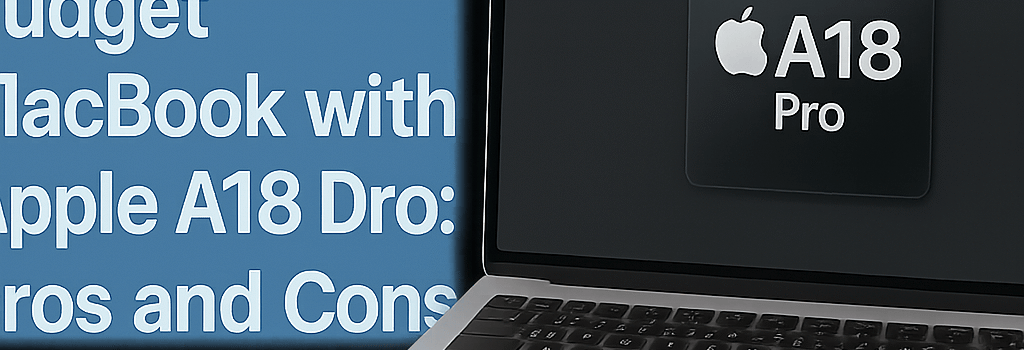Reviewing the Budget MacBook with Apple A18 Pro: Pros and Cons

Rumors of a low-cost MacBook equipped with Apple’s smartphone silicon have persisted for years. With recent supply-chain whispers pointing toward an A18 Pro–powered 13-inch laptop, it’s time to examine what such a machine could actually deliver: from raw performance and thermal behavior to ecosystem integration and market positioning.
Background: The Persistent Rumors of a Cheap MacBook
Speculation around a “budget MacBook” stretches back to the netbook craze of the late 2000s. Despite multiple shifts—three processor architectures (PowerPC, Intel, Apple Silicon), two CEOs, and global supply-chain upheavals—Apple’s entry-level laptops have hovered around the $999 mark for over two decades. Recent leaks from analyst Ming-Chi Kuo and a hidden “Mac17,1” reference in macOS betas have reignited talk of a $700–$800 MacBook sporting the A18 Pro chip, available in multiple colors much like Apple’s A16 iPad.
Technical Overview of the A18 Pro Chip
- CPU Configuration: 2 high-performance ‘Avalanche’ cores + 4 high-efficiency ‘Blizzard’ cores, built on TSMC’s 3 nm N3E process.
- GPU: 6-core Apple-designed GPU; up to 50% faster than A17 Pro’s 6-core GPU in synthetic tests.
- Memory: LPDDR5x at 7 600 MT/s; dual-channel width yielding ≈122 GB/s bandwidth. Typical iPhone SKUs ship with 8 GB, but a MacBook version could feasibly offer 12–16 GB.
- IO & Connectivity: USB 3.2 Gen 2 (10 Gbps) native support; lacks full Thunderbolt 3/4 PHY. Wi-Fi 6E and Bluetooth 5.3 integrated.
- Security & AI: Dedicated Secure Enclave, new 16-core Neural Engine capable of 18 TOPS, turbo-charging on-device machine learning tasks.
Performance Comparison: A18 Pro vs M1, M3, M4
Early Geekbench 6 and GFXBench data suggest the A18 Pro’s single-core scores rival or exceed the M1 by ≈15–20%. Multi-core performance aligns closely with M1, trailing M3 by 20–30% and M4 by 30–40%, owing to fewer high-performance cores. Graphics throughput sits between the M1’s 7-core GPU and the M3’s 8-core GPU.
“In single-threaded tasks—browser scripting, PDF rendering—the A18 Pro feels as snappy as my four-year-old M1 Air,” says John Poole, founder of Primate Labs. “Where it lags is sustained multicore workloads like compile farms or video transcodes.”
While Apple’s architectural refinements have closed the gap, the absence of hardware-accelerated Thunderbolt limits external GPU or ultra-high-speed storage configurations.
Use Cases: Ideal Workloads
- Everyday Productivity: Office suites (Word, Excel), web conferencing (Zoom, Teams), email and calendars.
- Web Browsing & Media: Safari, Chrome, streaming 4K content via Apple TV+ and Netflix, light photo editing in Photos or Pixelmator.
- On-Device Machine Learning: Real-time image classification, dictation, and simple ChatGPT-style inference with minimal latency.
- Casual Development: Web development with VS Code and local Node.js servers, small Xcode projects without massive asset catalogs.
Design and Portability
Evidence points to retaining the 2018-era MacBook Air chassis: a fanless unibody shell measuring 0.41–1.61 cm thick, weighing ≈1.25 kg. Battery capacity around 49 Wh—paired with the A18 Pro’s ~5 W idle and ~15–20 W peak—could deliver 12–15 hours of mixed usage. Color options may mirror the iPad’s blue, pink, and yellow finishes alongside silver and space gray.
Limitations: Multitasking, Pro Workloads, and Expandability
With two fewer Avalanche cores and limited GPU throughput versus M4, heavy compiles, 8K video transcoding, or large-scale parallel simulations will be noticeably slower. The 10 Gbps USB link caps high-speed external SSDs and docks. Moreover, if Apple defaults to 8 GB of RAM to hit a sub-$800 price point, intensive Photoshop layers or virtual machines will quickly exhaust memory.
Future-Proofing and Longevity
Apple typically supports modern Macs for 7–8 years of macOS updates. A bespoke A18 Pro MacBook launched in 2025 could see macOS 14 through 21 lifecycle coverage—on par with current M-series machines. However, marginal RAM and IO limits may shorten its viable lifespan for power users.
Integration into Apple’s Ecosystem
Fully compatible with iCloud Drive, Continuity Camera, Handoff, Sidecar, and Universal Control. The Neural Engine accelerates macOS features like Live Text and Visual Lookup. Apple Silicon parity ensures universal app compatibility, from iPhone-optimized apps to full Xcode builds.
Market Position and Pricing Strategy
Positioned beneath the $999 MacBook Air M4, an A18 Pro MacBook could undercut competing Windows ultrabooks (e.g., Snapdragon 8cx Gen 3 notebooks) by $100–200. Apple’s razor-and-blades approach—sacrificing higher margins on hardware for ecosystem lock-in—suggests a starting price of $749 for an 8 GB/256 GB SKU, $899 for 16 GB/512 GB.
Additional Analysis: Thermal Management and Power Envelope
TSMC’s 3 nm process yields a die size of ~120 mm². In a fanless design, the A18 Pro can sustain ≈5 W indefinitely, with short spikes up to 20 W before thermal throttling kicks in. Comparatively, the M2 Air’s active cooling allows sustained 15 W to 18 W workloads. Real-world impact: 20-minute video transcodes may take 50% longer on A18 Pro.
Additional Analysis: Developer and Enterprise Adoption
Enterprises evaluating Mac deployments will weigh lower hardware costs against potential productivity hits on CI/CD workloads. Docker Desktop and virtualization of ARM-linux containers run smoothly, but complex multi-architecture builds still favor M-series hardware. Xcode indexing remains swift for small to medium codebases.
Additional Analysis: Competitive Landscape
ChromeOS laptops with MediaTek Kompanio 1380 chips and Windows devices powered by Snapdragon 8cx Gen 3 offer similar battery life but trail Apple in sustained single-threaded performance and app compatibility. AMD’s 6 W Ryzen 7000U series competes on graphics but loses on ecosystem cohesion and native iOS/Mac app support.
Conclusion
A budget MacBook powered by the A18 Pro would excel at everyday tasks, provide best-in-class battery life in a fanless chassis, and deepen Apple’s value ladder beneath the Air. Yet its IO constraints, memory ceilings, and thermal limits make it less suitable for power users and enterprise CI/CD roles. For the right audience—students, writers, casual web developers, and ecosystem-locked consumers—an A18 Pro MacBook could strike the perfect balance of price, performance, and portability.